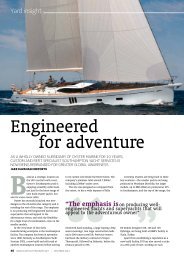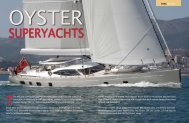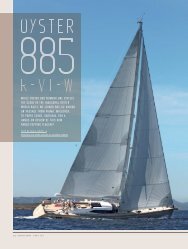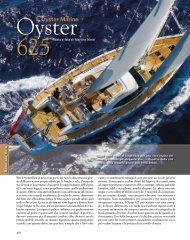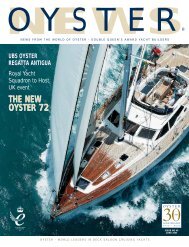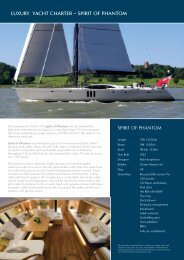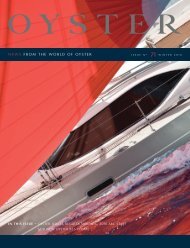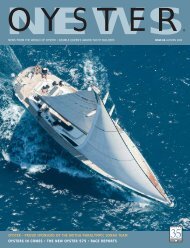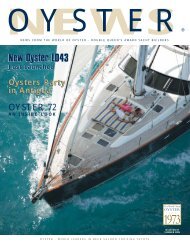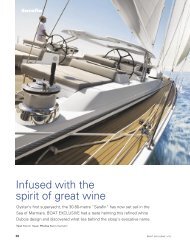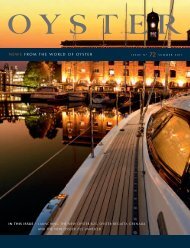You also want an ePaper? Increase the reach of your titles
YUMPU automatically turns print PDFs into web optimized ePapers that Google loves.
‘ Of medium build and<br />
height, Lord Amherst is<br />
an affable, good looking<br />
man in his 60s. Roly<br />
Franks, a sailing friend<br />
describes Amherst as<br />
"an eminently suitable<br />
person." Another of<br />
Amherst’s sailing crew<br />
says he is charming, a<br />
perfect diplomat, "a<br />
center of stimulation<br />
who never dominates<br />
’<br />
30 www.oystermarine.com<br />
The Yacht Squadron is, in fact, the hub of all<br />
matters having to do with yachting on the<br />
Solent Channel because it is located on the<br />
most northerly bulge of the shoreline of Cowes<br />
town on the Isle of Wight. At high tide, the<br />
Squadron’s waterside foundations are awash in<br />
the Solent, and with deep water carrying to<br />
within 100 feet of its mossy stone exterior, The<br />
Castle is the perfect stationary end of an allpurpose<br />
starting line. To race in the Solent, that<br />
busy body of tidal water separating the Isle of<br />
Wight from Britain’s south coast, start here.<br />
Henry VIII built the original structure in 1539<br />
as part of his coastal defence system.<br />
Originally a round block house flanked by two<br />
rectangular wings, with semi-circular<br />
battlements facing the Solent and a<br />
protective stone wall running along the back<br />
of the grounds, it has been expanded over<br />
the years. A large, colorful flower garden dips<br />
steeply to a wooden fence along the<br />
waterfront. An elegant glass pavilion is<br />
perched proudly on the crest of the lawn,<br />
facing the sea. The original structure still<br />
resembles a little fort, but its single, two-story<br />
tower carries the visual signature of a castle,<br />
the name that has stuck for centuries.<br />
Like any good fortification, The Castle looks<br />
formidable. Its guns were only fired in anger<br />
once, during the Civil War in 1642, and there<br />
are no indications those rounds did any<br />
damage. But its very presence deterred those<br />
who might consider acts of aggression in the<br />
1500s, and it served as an American<br />
command center for the D-Day invasion.<br />
Today it effectively presents an impenetrable<br />
facade to all but the 1000 yachtsmen and<br />
women who can boast membership of one<br />
sort or another (only 475 can vote in Club<br />
matters). Exclusivity is one thing, but castles<br />
conjure murky moats, drawbridges, and<br />
casks of boiling oil dumped from above.<br />
I first laid eyes on the Royal Yacht Squadron<br />
in September of 1979, 24 years ago to the<br />
month. The Castle was the focal point of a<br />
confusion of boats wrestling with nasty, short<br />
waves kicked up by strong wind against a<br />
wicked current - a typically gray, blustery day<br />
on the Solent. Rapid Red Funnel ferries were<br />
jetting cars and people back and forth to<br />
Southampton to the north. Tankers and<br />
freighters were steaming in and out to and<br />
from all parts of the world. A thousand small<br />
boats, gathered for the annual Cowes Week<br />
Regatta, had introduced chaos. And a<br />
hundred or so ocean yachts were preparing to<br />
start a race around Fastnet Rock off Ireland<br />
that would claim the lives of 15 sailors.<br />
From the deck of the maxi, Kialoa, as we<br />
prepared to start the Fastnet Race, I studied<br />
The Castle through binoculars. Aside from its<br />
unique architecture, what I remember best is<br />
the cadre of nattily attired officials who were<br />
manning the battlements, ties snugged into<br />
the stiff collars of white shirts, double<br />
breasted blazers buttoned, visored military<br />
caps in place over sober faces, backs<br />
straight as ram rods. This was our race<br />
committee. The other vision was the<br />
gleaming row of polished cannon (that once<br />
armed HMS Royal Adelaide) fanned out on<br />
the semi-circular stone patio below the<br />
barbican. A fellow in a sailor suit fired one of<br />
them, and we were off, some of us for good.<br />
Over our sandwiches, Lord Amherst<br />
recounted squadron history, how "The Yacht<br />
Club," as the Squadron was first known, was<br />
founded in 1815; how the first Commodore,<br />
the Earl of Yarborough, served for 20 years;<br />
how the Prince Regent became a member in<br />
1817, and three years later when he became<br />
George IV, "Royal" was added to the<br />
Squadron’s name. With that distinction came<br />
the authority to fly the Royal Navy’s white<br />
ensign. "Originally," Amherst said, "the club’s<br />
sailing involved following naval procedures<br />
and patterns. <strong>Yachts</strong> would go out and<br />
emulate naval manoeuvres on the command<br />
of the Commodore. If an owner could find a<br />
naval frigate to engage in a speed duel it<br />
was his lucky day. If he overtook the naval<br />
vessel, chances are the Admiralty would




